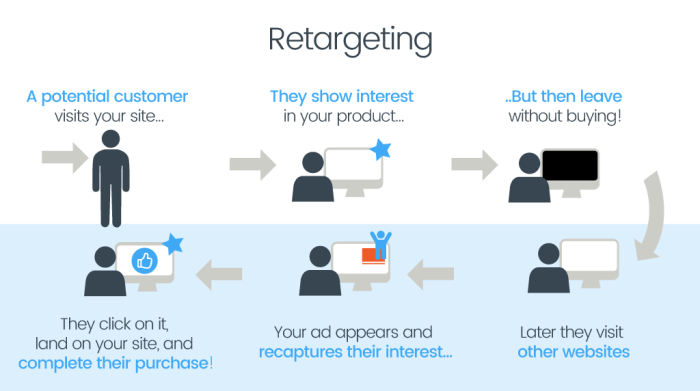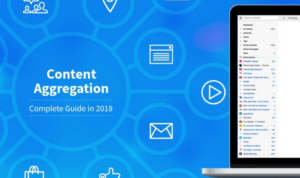Kicking off with Retargeting Ads Guide, this comprehensive guide will dive into the world of retargeting ads, covering everything from types and setup to targeting strategies and best practices. Get ready to elevate your advertising game!
Overview of Retargeting Ads
Retargeting ads, also known as remarketing ads, are a form of online advertising that targets users who have previously visited a website or interacted with a brand but did not make a purchase or complete a desired action. These ads work by using cookies to track users’ online behavior and display targeted ads to them as they browse the internet.
Benefits of Using Retargeting Ads for Businesses
Retargeting ads offer several benefits for businesses looking to increase conversions and engagement with their audience. Some of the key advantages include:
- Increased Conversion Rates: By targeting users who have already shown interest in a product or service, retargeting ads can help businesses convert those leads into customers.
- Improved Brand Awareness: Retargeting ads keep a brand top of mind for users who have previously engaged with the business, increasing brand recall and recognition.
- Cost-Effective Advertising: Since retargeting ads target a specific audience, businesses can optimize their ad spend and focus on users who are more likely to convert.
- Personalized Messaging: Retargeting ads allow businesses to deliver personalized messages and offers to users based on their previous interactions, increasing the relevance of the ad and the likelihood of conversion.
Examples of Successful Retargeting Ad Campaigns
Some notable examples of successful retargeting ad campaigns include:
- Amazon: Amazon uses retargeting ads to show users products they have viewed but not purchased, reminding them to complete their purchase and increasing conversion rates.
- Netflix: Netflix uses retargeting ads to target users who have visited their website but did not sign up for a subscription, offering them personalized recommendations and enticing offers to encourage sign-ups.
- Zappos: Zappos uses retargeting ads to show users products they have viewed or added to their cart but did not purchase, providing additional incentives such as discounts or free shipping to drive conversions.
Types of Retargeting Ads
When it comes to retargeting ads, there are different types that businesses can utilize to reconnect with potential customers who have shown interest in their products or services. These types include pixel-based retargeting, list-based retargeting, display retargeting, and dynamic retargeting.
Pixel-Based Retargeting
Pixel-based retargeting involves placing a tracking pixel on your website, which then tracks visitors and collects data on their behavior. This data is used to display targeted ads to these visitors as they browse other websites or social media platforms. This type of retargeting is effective in reminding potential customers about products they viewed on your site, encouraging them to return and make a purchase.
List-Based Retargeting
List-based retargeting involves uploading a list of customer emails or phone numbers to a retargeting platform. The platform then matches this information with its database to display targeted ads to these specific individuals. This type of retargeting is useful for reaching out to existing customers or leads and nurturing them through personalized ads.
Display Retargeting vs. Dynamic Retargeting
Display retargeting involves showing the same ad to all visitors who have previously interacted with your site. On the other hand, dynamic retargeting involves showing personalized ads based on the specific products or pages a visitor viewed on your site. Dynamic retargeting is more tailored and can lead to higher conversion rates compared to display retargeting.
Industries Benefit Most from Each Type
Pixel-based retargeting
E-commerce businesses benefit the most from this type as it helps remind potential customers about products they showed interest in.
List-based retargeting
Service-based businesses can benefit from this type by nurturing existing leads and customers through personalized ads.
Dynamic retargeting
Industries with a wide range of products or services, such as travel agencies or retailers, can benefit from dynamic retargeting to show personalized ads based on user preferences.
Setting Up Retargeting Ads: Retargeting Ads Guide

When it comes to setting up retargeting ads, you want to make sure you’re reaching the right people at the right time. Here’s how you can get started and optimize your campaigns for maximum impact.
Setting Up Retargeting Ads on Popular Platforms, Retargeting Ads Guide
- 1. Choose the Right Platform: Decide where you want to run your retargeting ads, whether it’s Google Ads, Facebook, or other platforms that support retargeting.
- 2. Install the Retargeting Pixel: Set up the retargeting pixel provided by the platform on your website to track visitors and their actions.
- 3. Create Audiences: Segment your website visitors based on their behavior, such as pages visited or actions taken, to create targeted audiences for your retargeting ads.
- 4. Design Your Ad Creative: Develop compelling ad creatives that resonate with your audience and encourage them to take action.
- 5. Set Budget and Schedule: Determine your ad budget and schedule to ensure your ads are shown to the right people at the right frequency.
Optimizing Retargeting Ad Campaigns
- 1. Test Different Ad Formats: Experiment with various ad formats like carousel ads, video ads, or dynamic product ads to see what works best for your audience.
- 2. Monitor Performance: Keep a close eye on your ad performance metrics and make adjustments as needed to optimize your campaigns for better results.
- 3. A/B Testing: Conduct A/B tests to compare different ad creatives, audiences, or messaging to identify the most effective combinations.
- 4. Retargeting Frequency: Avoid bombarding users with too many retargeting ads to prevent ad fatigue and ensure a positive user experience.
Creating Compelling Ad Creatives for Retargeting
- 1. Personalization: Tailor your ad creatives to the specific interests and behaviors of your retargeting audience to make your ads more relevant and engaging.
- 2. Clear Call-to-Action: Include a clear and compelling call-to-action in your ad creatives to prompt users to take the desired action, whether it’s making a purchase or signing up for a newsletter.
- 3. Visual Appeal: Use high-quality images or videos that capture attention and showcase your products or services in the best light.
- 4. Consistent Branding: Maintain consistent branding elements across all your ad creatives to reinforce brand recognition and trust with your audience.
Targeting Strategies for Retargeting Ads

When it comes to retargeting ads, having the right targeting strategy can make all the difference in reaching your desired audience effectively. Let’s dive into the various targeting options available and how they compare in terms of effectiveness.
Broad vs. Specific Targeting
- Broad Targeting: This approach casts a wide net, reaching a larger audience that may have shown some interest in your products or services. While this can increase visibility, it may not always lead to high conversion rates as the audience is not as targeted.
- Specific Targeting: On the other hand, specific targeting focuses on reaching a more defined audience based on their past interactions with your brand. By honing in on specific behaviors or demographics, you can tailor your ads to be more relevant and engaging, leading to higher conversion rates.
Audience Segmentation
- Demographic Segmentation: Divide your audience based on factors like age, gender, location, or income level to create more personalized ads that resonate with specific groups.
- Behavioral Segmentation: Segment your audience based on their past interactions with your website or previous purchases to target them with relevant ads that match their interests.
- Custom Audience Segmentation: Create custom audience segments by combining various factors like demographics, behaviors, and interests to create highly targeted ads for specific groups of users.






